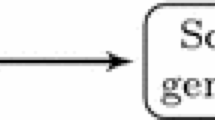Abstract
We explore futures hedging based on the global minimum variance strategy. As evidenced by using eleven of the world’s major stock market indexes and their corresponding futures contracts, the results show that the global minimum variance hedge may deviate statistically from the Ederington (J Finance 43(1):157–170, 1979) minimum variance hedge. We also present a regression approach to testing the hedge ratios and futures positions when the noise terms follow a normal distribution. In the illustration examined, we show that the global minimum variance hedge provides a more economically significant information ratio yield than that under the minimum variance hedge.

Similar content being viewed by others
References
Anderson, R. W., & Danthine, J.-P. (1981). Cross hedging. Journal of Political Economy, 89(6), 1182–1196.
Alexander, C., & Barbosa, A. (2007). Effectiveness of minimum-variance hedging. Journal of Portfolio Management, 33(2), 46–59.
Best, M. J., & Grauer, R. R. (1991). On the sensitivity of mean-variance portfolios to change in asset means: Some analytical and computation results, and the structure of asset expected returns. Review of Financial Studies, 4(2), 315–342.
Bodnar, T., & Okhrin, Y. (2013). Boundaries of the risk aversion coefficient: Should we invest in the global minimum variance portfolio? Applied Mathematics and Computation, 219(10), 5440–5448.
Bond, G. E., & Thompson, S. R. (1986). Optimal commodity hedging within the capital asset pricing model. Journal of Futures Markets, 6(3), 421–431.
Chang, J., & Shanker, L. (1987). A risk-return measure of hedging effectiveness: A comment. Journal of Financial and Quantitative Analysis, 22(3), 373–376.
Chopra, V. K., & Ziemba, W. T. (1993). The effects of errors in means, variance, and covariance on optimal portfolio choice. Journal of Portfolio Management, 19(2), 6–11.
Clarke, R. G., de Silva, H., & Thorley, S. (2011). Minimum-variance portfolio composition. Journal of Portfolio Management, 37(2), 31–45.
Ederington, L. H. (1979). The hedging performance of the new futures markets. Journal of Finance, 43(1), 157–170.
Howard, C., & D’Antonio, L. (1984). A risk-return measure of hedging effectiveness. Journal of Financial and Quantitative Analysis, 19(1), 101–112.
Johnson, L. L. (1960). The theory of hedge and speculation in commodity futures. Review of Economics Studies, 27(3), 139–151.
Kahl, K. H. (1983). Determination of the recommended hedging ratio. American Journal of Agricultural Economics., 65(3), 603–605.
Kempf, A., & Memmel, C. (2006). Estimating the global minimum variance portfolio. Schmalenbach Business Review, 58(4), 332–348.
Kuo, C.-K., & Chen, K.-W. (1995). A risk-return measure of hedging effectiveness: A simplification. Journal of Futures Markets, 15(1), 39–44.
Laws, J., & Thompson, J. (2005). Hedging effectiveness of stock index futures. European Journal of Operational Research, 163(1), 177–191.
Lesmond, D. A. (2005). Liquidity of emerging markets. Journal of Financial Economics, 77(2), 411–452.
Levy, H. (1987). Futures, spots, stocks, and bonds: Multi-asset portfolio analysis. Journal of Futures Markets, 7(4), 383–395.
Lien, D., & Shrestha, K. (2008). Hedging effectiveness comparisons: A note. International Review of Economics and Finance, 17(3), 391–396.
Lindahl, M. (1992). Minimum variance hedge ratios for stock index futures: Duration and expiration effects. Journal of Futures Markets, 12(1), 33–53.
Satyanarayan, S. (1998). A note on a risk-return measure of hedging effectiveness. Journal of Futures Markets, 18(7), 595–605.
Seber, G. A. F. (1977). Linear regression analysis. Hoboken: Wiley.
Stulz, R. M. (1984). Optimal hedging policies. Journal of Financial and Quantitative Analysis, 19(2), 127–140.
Terry, E. (2005). Minimum-variance futures hedging under alternative return specifications. Journal of Futures Markets, 25(6), 37–552.
You, L., & Daigler, R. T. (2013). A Markowitz optimization of commodity futures portfolios. Journal of Futures Markets, 33(4), 343–368.
Acknowledgements
The author gratefully acknowledges a partial financial support from the National United University through project 107-NUUPRJ-11.
Author information
Authors and Affiliations
Corresponding author
Additional information
Publisher's Note
Springer Nature remains neutral with regard to jurisdictional claims in published maps and institutional affiliations.
Rights and permissions
About this article
Cite this article
Chiu, WY. The global minimum variance hedge. Rev Deriv Res 23, 121–144 (2020). https://doi.org/10.1007/s11147-019-09159-8
Published:
Issue Date:
DOI: https://doi.org/10.1007/s11147-019-09159-8




